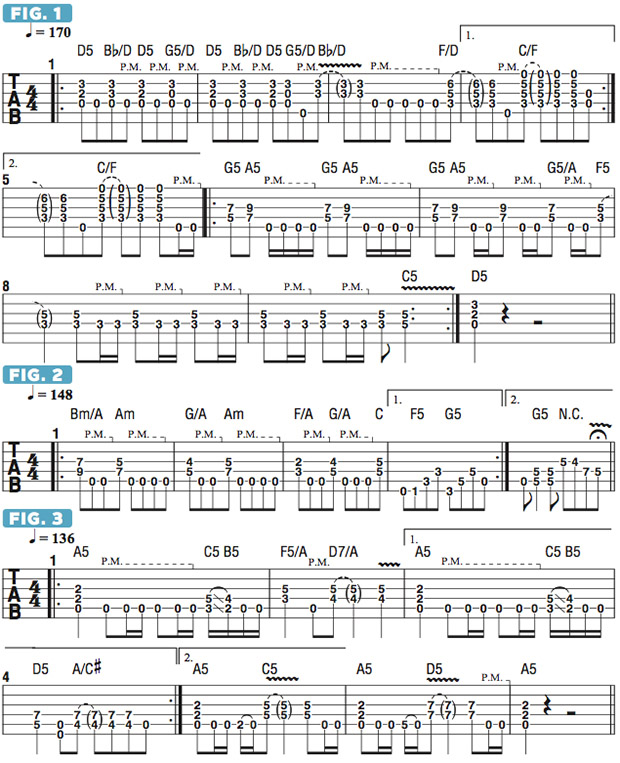How to Construct Classic Eighties-Style Metal Guitar Parts
Learn three “classic” metal-style riffs packed with melodic movement.
Back in the Eighties, during the heyday of metal, bands like Van Halen, Judas Priest and the Scorpions were releasing incredible, killer albums packed with amazing guitar playing.
Today, I feel that the majority of metal is more focused on rhythmic parts with less harmonic movement than what I think of as the approach representative of Eighties-style metal. It is from that perspective that I put together the three “classic” metal-style riffs.
During the NWOBHM (New Wave of British Heavy Metal) days of the late Seventies and early Eighties, bands like Iron Maiden and Judas Priest were forging blazing, melodic metal earmarked by powerful and memorable song riffs.
FIGURE 1 is indicative of Iron Maiden’s style: above the progression of three different pedal tones, shifting two- and three-note chord shapes create the melodic content that keeps this part interesting and moving forward.
I begin with an open D5 power chord, using the D string as a repeating pedal tone, and by simply changing the note on the G string, I can move from D5 to Bb/D to G5/D. Be sure to palm-mute all of the open D pedal tones while allowing the higher strings to ring clearly. In bar 3 into bar 4, I shift to an F5 power chord followed by C/F, sounded by lowering the high F on the B string one fret to E, played in unison with the open high E string.
After the second ending (bar 5), I transition to the key of A minor, with sliding two-note power chord shapes fretted on the D and G strings, supported by an open A-string pedal tone that is picked in consecutive 16th notes. In bar 8, I move down two whole steps to F5 and use the fretted F note as the pedal tone, followed at the end of bar 9 with a shift from F5 to C5, performed by simply moving from F to G on the D string while keeping the C note on top.
FIGURE 2 is played at a slower tempo, and, as with FIGURE 1, the melodic content in this riff is provided by the simple movement of two-note chord shapes sounded above a pedal tone. In bars 1–3, the open A string provides the pedal tone, over which I play a sequence of double-stops that imply Bm, Am, G and F chords. In this example, the melodic element comes from the highest note in each double-stop.
Let’s wrap up with a lick reminiscent of George Lynch with Dokken or Queensrÿche, specifically from the latter band’s Operation: Mindcrime period, in terms of the overall approach to the riffs and the feel of the rhythms.
In FIGURE 3, I begin with an A5 power chord followed by a repeating open A-string pedal tone, and at the end of bar 1 I use sliding two-note power chords to transition to F5, followed by D7/A, which I sound by moving from F up one fret to F# on the D string. In bar 4, I use the opposite movement, shifting down one fret from D to C# on the A string to change from D5 to A/C#. At the end of the riff, I use pull-offs on the A string to set up the two-note C5 and D5 power chords.

Get The Pick Newsletter
All the latest guitar news, interviews, lessons, reviews, deals and more, direct to your inbox!
“There are so many sounds to be discovered when you get away from using a pick”: Jared James Nichols shows you how to add “snap, crackle and pop” to your playing with banjo rolls and string snaps
Don't let chord inversions bamboozle you. It's simply the case of shuffling the notes around







![Joe Bonamassa [left] wears a deep blue suit and polka-dotted shirt and plays his green refin Strat; the late Irish blues legend Rory Gallagher [right] screams and inflicts some punishment on his heavily worn number one Stratocaster.](https://cdn.mos.cms.futurecdn.net/cw28h7UBcTVfTLs7p7eiLe.jpg)


